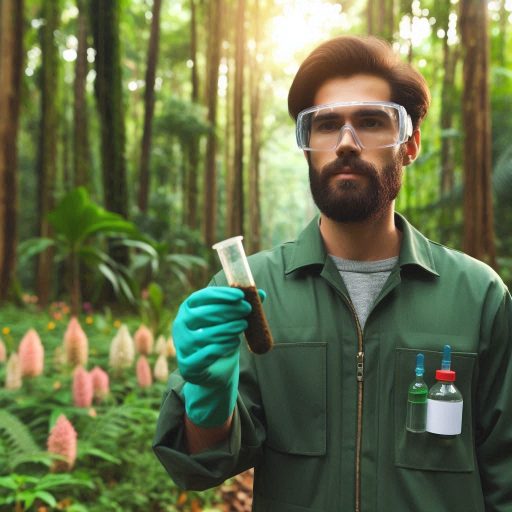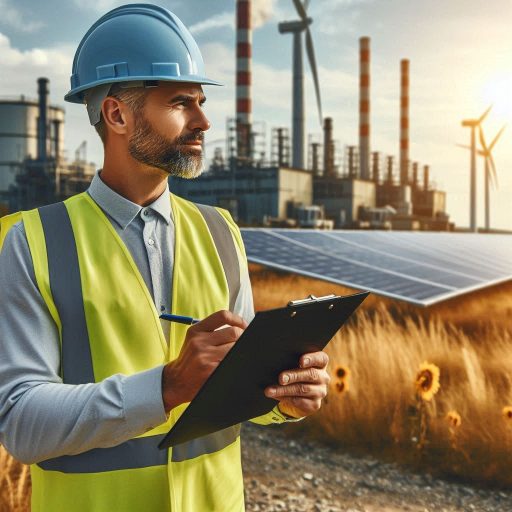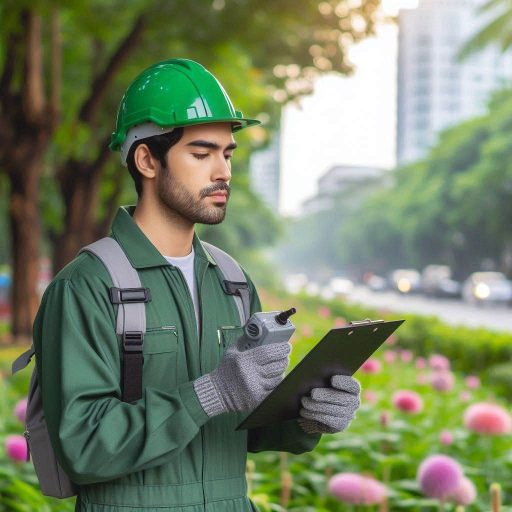Introduction
Environmental technicians play a vital role in safeguarding our environment.
They monitor air, water, and soil quality to ensure compliance with regulations.
Their work helps identify and mitigate environmental hazards, supporting both public health and sustainability efforts.
By analyzing data and managing environmental assessments, technicians contribute significantly to pollution control and environmental conservation.
Technology is increasingly shaping the roles of environmental technicians.
Advanced instruments and software enhance their ability to collect and analyze data with greater accuracy.
For instance, remote sensing technologies allow for more efficient monitoring of large areas and hard-to-reach locations.
Geographic Information Systems (GIS) provide detailed spatial analysis, helping technicians visualize and interpret environmental data more effectively.
Innovative tools such as automated sensors and drones are revolutionizing fieldwork.
These technologies enable real-time data collection and reduce manual labor, improving efficiency and precision.
Data management software helps technicians process and store large volumes of information, facilitating better decision-making and reporting.
Additionally, predictive analytics and modeling tools allow technicians to forecast environmental trends and potential issues.
Overall, technology enhances the capabilities of environmental technicians, making their work more effective and streamlined.
Evolution of Environmental Technician Roles
How environmental technician roles have evolved over the years
The role of environmental technicians has significantly evolved due to technological advancements.
Traditionally, their work focused on manual tasks and basic fieldwork.
Over the years, technology has transformed how they perform their duties, increasing efficiency and accuracy.
Technicians now use sophisticated tools and software to enhance their capabilities.
This evolution has broadened their responsibilities and expanded their impact on environmental protection.
Traditional Tasks of Environmental Technicians
In the past, environmental technicians primarily conducted hands-on tasks and manual data collection.
They performed routine inspections and collected samples from various environmental media, such as soil, water, and air.
Analyzing these samples often required basic lab equipment and manual methods.
Fieldwork involved measuring pollution levels and checking compliance with environmental regulations.
Documenting findings and preparing reports were also key aspects of their traditional roles.
The process was labor-intensive and time-consuming, relying heavily on manual data entry and analysis.
Impact of Technological Advancements
Technological advancements have revolutionized the role of environmental technicians.
Modern tools and instruments now enable more precise and efficient data collection.
Techniques such as remote sensing and GPS technology allow for more extensive and accurate environmental monitoring.
Advanced analytical software has streamlined data processing and interpretation.
Technicians can now perform real-time monitoring and analysis, enhancing their ability to address environmental issues promptly.
Drones and automated systems have also improved their ability to gather data from challenging or hazardous locations.
Transition to Digital Tools and Techniques
The shift from manual to digital tools has transformed how environmental technicians work.
Data collection is now more automated, reducing human error and increasing accuracy.
Digital platforms allow for more efficient data management and sharing.
Technicians use Geographic Information Systems (GIS) to map and analyze environmental data spatially.
The integration of big data and machine learning enables more complex analyses and predictions.
This technological shift has also facilitated better collaboration with other professionals and stakeholders.
Increased Focus on Data Analysis and Reporting
With technological advancements, the focus has shifted from manual tasks to sophisticated data analysis.
Environmental technicians now spend more time interpreting data and using advanced modeling tools.
Reporting has become more detailed and informative, thanks to improved software.
Technicians can generate comprehensive reports that offer deeper insights into environmental conditions and trends.
This evolution has enhanced their ability to make data-driven decisions and provide valuable recommendations for environmental management.
Read: CAD Technician vs. Draftsman: Key Differences
Incorporation of Technology
Integration of Technology into Environmental Technician Roles
Technology has profoundly transformed the role of environmental technicians.
Modern tools and software have revolutionized data collection, analysis, and management.
Technicians now rely on advanced technology to enhance accuracy and efficiency in their work.
This integration enables more precise environmental monitoring and more effective problem-solving.
Advanced Tools in Environmental Technology
One significant technological advancement is the use of Geographic Information Systems (GIS).
GIS technology allows technicians to map and analyze environmental data spatially.
This tool helps in tracking pollution sources, assessing land use, and managing natural resources.
GIS provides a visual representation of data, making it easier to understand complex environmental patterns.
Another essential tool is remote sensing technology
Remote sensing involves using satellites or drones to collect environmental data from a distance.
This method enables technicians to monitor large areas without physically being present.
It is particularly useful for tracking changes in vegetation, water bodies, and pollution levels over time.
Environmental technicians also use sophisticated analytical instruments, such as gas chromatographs and mass spectrometers.
These instruments analyze air and water samples with high precision.
They detect pollutants and contaminants at very low concentrations, which is crucial for assessing environmental quality and ensuring regulatory compliance.
Software Applications for Data Management
Technicians utilize various software applications for managing and analyzing environmental data.
Environmental modeling software helps predict the impact of pollutants and assess environmental risks.
These models simulate different scenarios, aiding in decision-making and policy development.
Data management systems are also vital.
These systems store and organize large volumes of environmental data collected from fieldwork.
They facilitate easy access, retrieval, and analysis of data, improving efficiency and accuracy in reporting.
Real-Time Monitoring and Reporting
Real-time monitoring systems have become integral to environmental technician roles.
These systems use sensors to provide continuous data on environmental conditions.
Real-time data allows for immediate responses to environmental issues, such as detecting spills or changes in air quality.
Additionally, mobile apps and cloud-based platforms enable technicians to collect and share data on the go.
These tools enhance collaboration and streamline data entry and analysis.
They also provide access to real-time information from various locations, supporting fieldwork and remote consultations.
Enhancing Efficiency and Accuracy
The integration of technology into environmental technician roles enhances both efficiency and accuracy.
Advanced tools and software streamline data collection, improve analysis, and facilitate better decision-making.
By leveraging these technologies, environmental technicians can address environmental challenges more effectively and contribute to sustainable solutions.
Technology has significantly impacted environmental technician roles by providing advanced tools and software for data management and analysis.
GIS, remote sensing, analytical instruments, and real-time monitoring systems have transformed how technicians work, enhancing their ability to monitor and protect the environment.
Read: CAD Technician Certification: What You Need to Know
Data Collection and Analysis
The Role of Technology in Data Collection
Technology plays a crucial role in data collection for environmental technicians.
Modern tools and equipment streamline the process of gathering environmental data.
Sensors and remote monitoring devices collect real-time data on air, water, and soil quality.
GPS technology enables precise location tracking and mapping.
Drones provide aerial views and collect data from hard-to-reach areas.
These technological advancements help technicians gather comprehensive and accurate data efficiently.
Improved Accuracy with Advanced Technology
Technological advancements significantly improve the accuracy of environmental data collection.
High-precision sensors measure pollutants and environmental variables with greater detail.
Automated systems reduce human error and ensure consistent data recording.
Digital instruments provide immediate feedback and allow for real-time data analysis.
This enhanced accuracy helps in making informed decisions and ensures compliance with environmental regulations.
Reliable data is essential for assessing environmental conditions and implementing effective solutions.
Enhanced Efficiency Through Automation
Technology also boosts efficiency in environmental data collection and analysis.
Automated data collection systems reduce the need for manual sampling and processing.
Remote sensors and data loggers continuously monitor environmental conditions without frequent human intervention.
Data analysis software processes large volumes of information quickly and accurately.
This automation speeds up the data collection process and allows technicians to focus on interpreting results and implementing solutions.
Improved efficiency leads to faster response times and more effective environmental management.
Real-Time Data and Decision-Making
Real-time data collection provides immediate insights into environmental conditions.
Technologies like IoT (Internet of Things) devices transmit data instantly to central systems.
This capability allows environmental technicians to make timely decisions and address issues as they arise.
For example, real-time air quality monitoring can trigger alerts for pollution spikes, enabling rapid response.
Access to up-to-date information enhances the ability to manage environmental risks effectively and ensures proactive measures.
Data Integration and Analysis Tools
Advanced data integration and analysis tools facilitate comprehensive assessments.
Software platforms consolidate data from multiple sources, providing a holistic view of environmental conditions.
Analytical tools process complex datasets to identify trends, patterns, and potential issues.
Geographic Information Systems (GIS) offer spatial analysis and visualization of environmental data.
These integrated tools enhance the ability to analyze and interpret data accurately, supporting better decision-making and planning.
Read: Essential Skills for CAD Technicians
Transform Your Career Today
Unlock a personalized career strategy that drives real results. Get tailored advice and a roadmap designed just for you.
Start Now
Monitoring and Reporting
Technology Enhancing Monitoring and Reporting Processes
Technology has significantly enhanced monitoring and reporting processes for environmental technicians.
Advanced tools and software now streamline data collection and analysis.
These improvements lead to more accurate and timely environmental assessments.
Modern sensors play a crucial role in environmental monitoring.
Air quality sensors, for example, measure pollutants and particulate matter with high precision.
Water quality sensors track parameters such as pH, turbidity, and contamination levels in real time.
These devices provide immediate data, which helps technicians address environmental issues swiftly.
Remote sensing technology offers another significant advancement.
Satellites and drones capture detailed images and data from large areas.
This technology allows technicians to monitor ecosystems, track deforestation, and assess pollution levels over vast regions.
Remote sensing enhances the ability to collect data from otherwise inaccessible locations.
Specific devices and software used for this purpose
Devices
- Spectrophotometers: Measure light absorption in samples to determine concentrations of pollutants.
- Gas Chromatographs: Analyze chemical compounds in air, water, or soil samples.
- Water Quality Sensors: Monitor parameters such as pH, turbidity, and dissolved oxygen in water bodies.
- Soil Moisture Meters: Measure soil moisture levels to assess irrigation needs and soil health.
- Drones: Capture aerial images and collect data from hard-to-reach locations for environmental monitoring.
- Automated Environmental Sensors: Track and record various environmental parameters in real-time, such as air quality and temperature.
Software
- Geographic Information Systems (GIS): Analyze and visualize spatial data to assess environmental conditions and trends.
- Environmental Data Management Systems (EDMS): Store, manage, and analyze large datasets related to environmental monitoring.
- Statistical Analysis Software: Perform statistical analysis on environmental data to identify trends and anomalies.
- Modeling and Simulation Software: Predict environmental impacts and simulate scenarios based on data inputs.
- Remote Sensing Software: Analyze satellite or aerial imagery to monitor environmental changes and conditions.
These tools and software enhance the efficiency, accuracy, and scope of environmental monitoring and management tasks, helping technicians address environmental challenges effectively.
Read: Day in the Life of a CAD Technician
Environmental Impact Assessment
Improved Environmental Impact Assessments Through Technology
Technology has revolutionized the process of conducting environmental impact assessments (EIAs).
Advanced software tools and modeling programs enhance the accuracy and efficiency of assessments.
These tools analyze vast amounts of data quickly, providing comprehensive insights into potential environmental impacts.
Geographic Information Systems (GIS) enable technicians to visualize and analyze spatial data.
GIS technology helps in mapping environmental features and assessing potential impacts on different land uses.
Remote sensing technologies, such as satellites and drones, offer real-time data and high-resolution images of the environment.
This technology improves the accuracy of impact assessments and allows for better monitoring of changes over time.
Data analytics and machine learning algorithms further refine impact assessments
These technologies process large datasets to identify patterns and predict potential environmental impacts.
They also simulate various scenarios to evaluate the potential consequences of different actions or projects.
This predictive capability allows for more informed decision-making and proactive measures to mitigate adverse effects.
Additionally, technology facilitates collaboration among stakeholders.
Cloud-based platforms enable the sharing of data and findings among teams, regulatory agencies, and the public.
This transparency ensures that all relevant parties can access and review impact assessment results.
It also streamlines the review process, making it more efficient and collaborative.
Predicting and Mitigating Environmental Risks with Technology
Technology plays a critical role in predicting and mitigating environmental risks.
Predictive modeling tools help technicians assess potential environmental risks before they occur.
These models use historical data and current conditions to forecast future impacts, allowing for early intervention.
Environmental monitoring technologies, such as sensors and automated systems, provide real-time data on environmental conditions.
These tools detect changes in air and water quality, soil health, and other critical parameters.
By monitoring these factors continuously, technicians can identify potential risks and address them promptly.
Risk mitigation strategies are also enhanced by technology
Advanced simulation software helps in developing and testing mitigation measures before implementation.
This ensures that the chosen strategies are effective and suitable for the specific environmental context.
Technology also aids in the design and implementation of remediation projects, such as pollution cleanup or habitat restoration.
Moreover, technology supports the development of sustainable solutions.
Innovations in renewable energy, waste management, and pollution control technologies reduce environmental risks by minimizing adverse impacts.
Technicians can leverage these technologies to implement effective solutions that align with environmental regulations and sustainability goals.
Gain More Insights: Environmental Technician Job Market Trends 2024
Discover More: Cloud Networking: What Network Engineers Need to Know
Uncover the Details: Choosing the Right Chemical Engineering Degree
Remote Sensing and Mapping
Technology in Remote Sensing and Mapping
Environmental technicians increasingly use technology for remote sensing and mapping to improve their work efficiency.
Remote sensing technology collects data from a distance, allowing technicians to monitor environmental conditions without direct contact.
This approach provides real-time information on various environmental factors, such as air quality, water levels, and land use.
Benefits of Using Drones
Drones are a valuable tool for environmental technicians.
They offer high-resolution aerial imagery that helps in detailed site assessments.
Drones can easily access hard-to-reach areas, providing data that would otherwise be difficult or dangerous to obtain.
They assist in tracking wildlife, assessing vegetation health, and monitoring pollution sources.
Drones also enhance efficiency by reducing the time and cost associated with traditional field surveys.
Technicians can quickly gather large amounts of data, which improves the accuracy and timeliness of their analysis.
The ability to capture images and videos from various angles provides a comprehensive view of environmental conditions.
Advantages of Satellites
Satellites play a crucial role in environmental monitoring and mapping.
They offer broad coverage, capturing data on a global scale.
Satellites provide valuable information on climate patterns, deforestation, and natural disasters.
This data helps technicians understand large-scale environmental changes and assess their impacts.
Satellites also enable long-term monitoring by capturing consistent data over time.
This capability is essential for tracking changes in land use, water resources, and atmospheric conditions.
The historical data collected by satellites allows for trend analysis and better forecasting of environmental issues.
Utilizing GIS Technology
Geographic Information Systems (GIS) are another key technology for environmental technicians.
GIS integrates various data sources into a single platform, allowing for detailed spatial analysis.
Technicians use GIS to create maps that visualize data on pollution levels, habitat distribution, and other environmental factors.
GIS helps in decision-making by providing a clear view of spatial relationships and patterns.
It supports scenario planning and impact assessment by analyzing how different factors interact.
This technology enhances the ability to design and implement effective environmental management strategies.
Practical Applications and Integration
Integrating drones, satellites, and GIS technology into environmental work streamlines data collection and analysis.
Technicians can combine aerial imagery from drones with satellite data and GIS layers for a comprehensive view of environmental conditions.
This integration improves accuracy and provides a more complete picture of environmental challenges.
Using these technologies also facilitates collaboration among teams and stakeholders.
Shared data and visualizations enhance communication and support more informed decision-making.
Technicians can present data in a more accessible format, making it easier to convey complex information to non-specialists.
Technology has significantly impacted the role of environmental technicians.
Remote sensing, drones, satellites, and GIS offer advanced tools for monitoring, mapping, and analyzing environmental conditions.
These technologies enhance efficiency, accuracy, and the ability to address environmental issues effectively.
You Might Also Like: Top Universities for Nuclear Engineering Programs
Training and Skill Development
The Need for Technology-Related Skills
The role of environmental technicians increasingly depends on technology.
Modern environmental monitoring relies heavily on sophisticated tools and software.
Technicians must acquire technology-related skills to stay effective in their roles.
Proficiency in these technologies improves data accuracy and efficiency.
As technology evolves, so do the methods and tools used in environmental work.
Technicians need to adapt to these changes to maintain high standards in their profession.
Embracing New Technologies
New technologies, such as remote sensing and data analytics, are transforming environmental management.
Environmental technicians must learn to operate advanced equipment like drones and sensor networks.
Understanding software for data analysis and environmental modeling becomes essential.
These technologies enhance the ability to monitor and manage environmental conditions more effectively.
Technicians who embrace these advancements can provide more accurate and timely solutions.
Importance of Ongoing Training
Ongoing training is crucial for mastering new technologies.
Environmental technologies evolve rapidly, making continuous learning essential.
Technicians should seek training programs and workshops to keep their skills up-to-date.
Regular updates on the latest tools and techniques ensure they remain competent in their roles.
Professional development helps technicians adapt to technological changes and stay ahead in their field.
Transform Your Career Today
Unlock a personalized career strategy that drives real results. Get tailored advice and a roadmap designed just for you.
Start NowProfessional Development Opportunities
Many organizations offer professional development opportunities tailored to environmental technicians.
Online courses, certifications, and seminars provide access to the latest advancements in technology.
Attending industry conferences and workshops can also expand knowledge and skills.
These opportunities often include hands-on training with new equipment and software.
Technicians should actively pursue these options to enhance their technical expertise and career prospects.
Staying Current with Industry Trends
Technicians should stay informed about emerging trends in environmental technology.
Following industry publications and news helps in understanding technological advancements.
Engaging with professional networks and forums provides insights into new tools and methods.
This awareness allows technicians to adapt their practices and utilize the latest technologies effectively.
Staying current with industry trends ensures they can apply the most effective solutions to environmental challenges.
Enhancing Job Performance
Acquiring and refining technology-related skills directly impacts job performance.
Technicians with advanced technological skills can perform tasks more efficiently and accurately.
This proficiency improves data collection, analysis, and reporting processes.
Enhanced skills also lead to better problem-solving and decision-making.
Investing in technology training boosts overall job performance and contributes to career growth.
Uncover the Details: Day in the Life of a Cybersecurity Analyst Explained
Uncover the Details: How Robotics Engineers Are Shaping the Future of Tech
Discover More: Daily Tasks of a Transportation Engineer Explained
Conclusion
Technology significantly impacts the role of environmental technicians, transforming how they perform their duties.
Advanced tools and systems enhance efficiency and accuracy in monitoring and data collection.
Environmental sensors and drones provide real-time data, enabling technicians to respond quickly to environmental changes and potential hazards.
Geographic Information Systems (GIS) help technicians analyze spatial data and visualize environmental trends.
These technologies improve decision-making and facilitate better resource management.
Automated data management systems streamline the collection, storage, and analysis of environmental data, reducing manual errors and increasing productivity.
Remote sensing technology allows technicians to monitor large areas without being physically present.
This capability is crucial for tracking environmental conditions and detecting issues in remote or hazardous locations.
Enhanced communication tools enable better collaboration among technicians and other stakeholders, improving the effectiveness of environmental projects.
Embracing technology is essential for advancing environmental practices and sustainability efforts.
Technicians who leverage these tools can perform their tasks more effectively and make data-driven decisions.
Staying updated on technological advancements ensures that technicians remain at the forefront of the field, driving innovation and improving environmental outcomes.
[E-Books for Sale]
The Big Book of 500 High-Paying Jobs in America: Unlock Your Earning Potential
$19.99 • 500 High-Paying Jobs • 330 pages
Explore 500 high-paying jobs in America and learn how to boost your career, earn more, and achieve success!
See All 500 High-Paying Jobs of this E-Book
1001 Professions Without a Degree: High-Paying American Jobs You Can Start Now
$19.99 • 1001 Professions Without a Degree • 174 pages
Discover 1001 high-paying jobs without a degree! Unlock career tips, skills, and success strategies for just $19.99!




